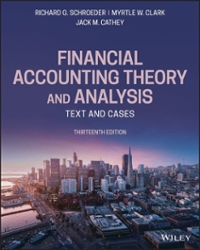Answered step by step
Verified Expert Solution
Question
1 Approved Answer
These are all TRUE/FALSE questions A trend percentage is calculated as the current year divided by the base year. Most public companies present trend information
These are all TRUE/FALSE questions
- A trend percentage is calculated as the current year divided by the base year.
- Most public companies present trend information in their annual reports.
- The total assets dollar amount is typically used as the base for a common-size balance sheet analysis.
- Most accounting computer programs, such as QuickBooks, provide common-size analysis reports.
- The current ratio is the same as the quick ratio.
- If Company A had earnings per share of $4 and Company B had earnings per share of $3, then it is accurate to conclude that Company A was more profitable.
- If a company's return on assets is higher than its return on shareholders' equity, then it has positive financial leverage.
- Companies with higher inventory turnover ratios tend to have lower inventory costs, including lower inventory storage and insurance costs, than companies with lower inventory turnover ratios.
- In general, managers prefer expenses as a percent of net sales to increase over time.
- In general, managers prefer the profit margin ratio to decrease over time.
- The quick ratio is a short-term liquidity ratio.
- Times interest earned indicates the company's ability to cover its interest expense related to long-term debt with current period earnings..
- A current ratio of greater than 1.0 would indicate that current assets exceed current liabilities.
- Return on assets is calculated as average total assets divided by net income.
- The debt to assets ratio is calculated as total assets divided by total liabilities.
- A relatively high price-earnings ratio indicates investors expect favorable future earnings.
- Return on assets is a market valuation measure.
Step by Step Solution
There are 3 Steps involved in it
Step: 1

Get Instant Access to Expert-Tailored Solutions
See step-by-step solutions with expert insights and AI powered tools for academic success
Step: 2

Step: 3

Ace Your Homework with AI
Get the answers you need in no time with our AI-driven, step-by-step assistance
Get Started


